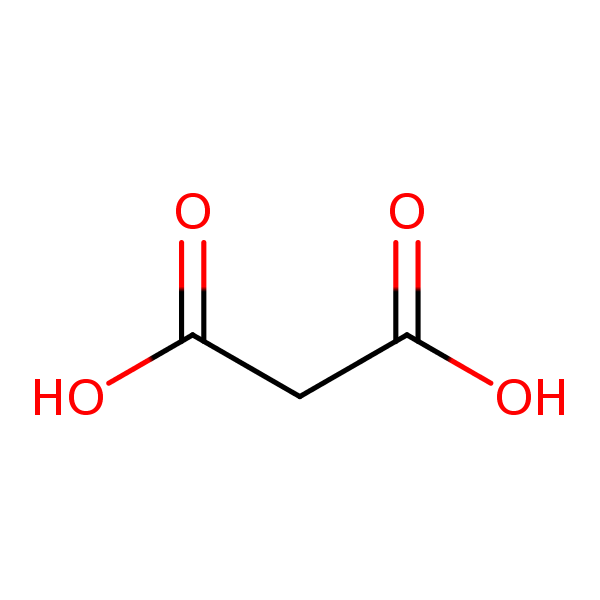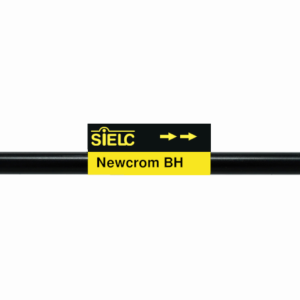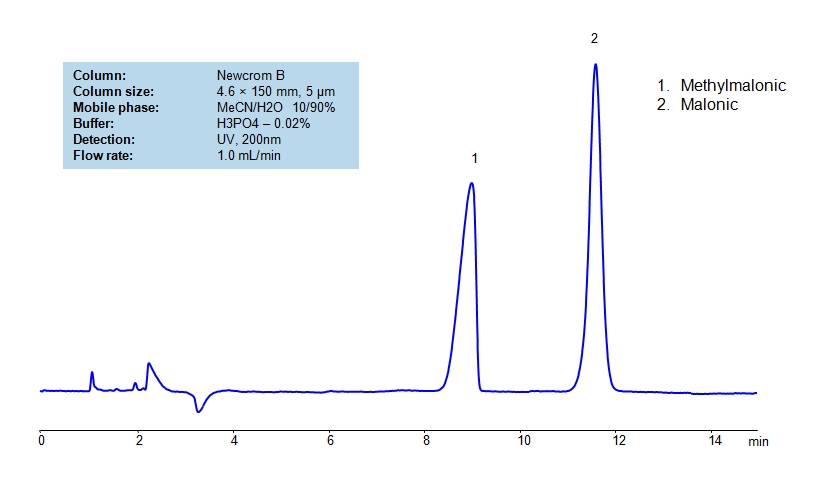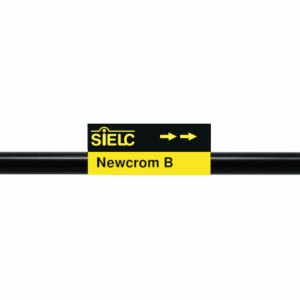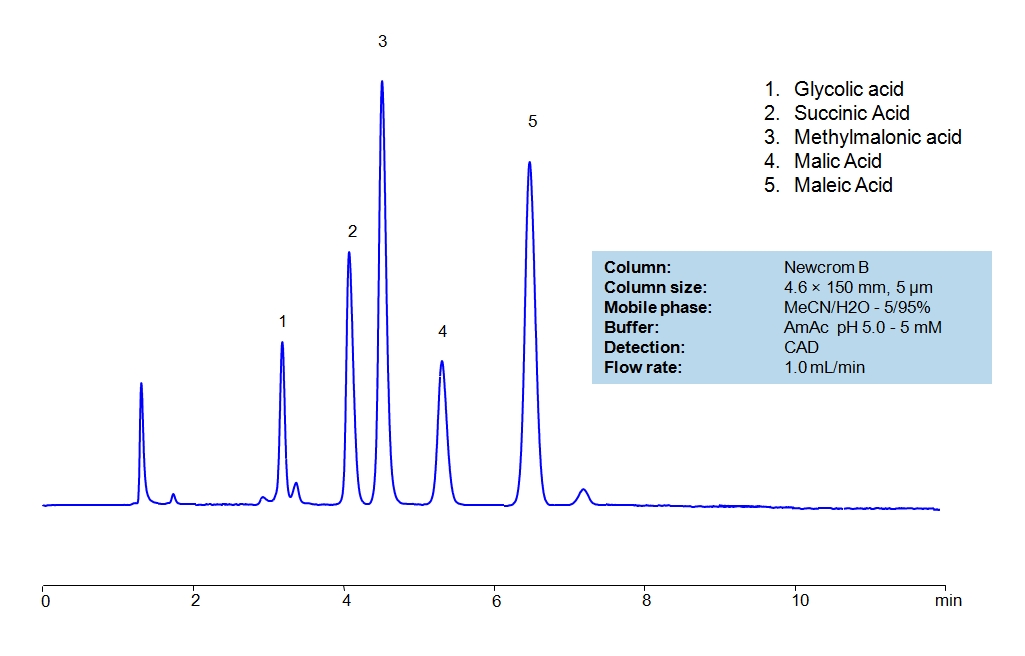| CAS Number | 141-82-2 |
|---|---|
| Molecular Formula | C3H4O4 |
| Molecular Weight | 104.061 |
| InChI Key | OFOBLEOULBTSOW-UHFFFAOYSA-N |
| LogP | -0.810 |
| Synonyms |
|
Applications:
HPLC Separation of Sorbic, Fumaric, Malonic Acids on Newcrom BH Column
June 25, 2020
HPLC Method for Sorbic acid, Fumaric Acid, Malonic Acid on Newcrom BH by SIELC Technologies
High Performance Liquid Chromatography (HPLC) Method for Analysis of Sorbic acid, Fumaric Acid, Malonic Acid.
Sorbic acid is used as a preservative in food, drinks, and cosmetics. It works through inhibiting the growth of molds, yeasts, and some bacteria. While it is considered safe, studies have connected it to hyperactivity in children when mixed with other additives. It has the chemical formula C6H8O2.
Fumaric Acid, also known as trans-butenedioic acid, is an organic compound with C4H4O4 chemical formula. It is used across food, industrial, and medical industries. In food, is it often used as a preservative, pH regulator, and flavoring akin to citric acid. Industrially, it is used in making polyester resins, polyhydric alcohols, and more. Medically, it is used in denture cleaners and it’s derivatives are used in treating psoriasis.
Malonic Acid is an organic acid with the C3H4O4 chemical formula. It has a variety of uses from synthesis to preservatives. When it comes to synthesis, it is often used in industrial means. and especially dyes for natural fibers. Besides industrial use, in laboratory environments, it is used in preparation of tris-maleate, sodium maleate buffers, and maleate salts.
You can find detailed UV spectra of Fumaric Acid and information about its various lambda maxima by visiting the following link.
Acids with different strengths can be retained and elution order controlled by the use of a mixed-mode column, which has an ion-exchange component in addition to hydrophobic retention. In this example, the Newcrom BH mixed-mode column was used to separate fumaric, malonic and sorbic acids in HPLC. Sorbic acid was mostly retained by hydrophobicity, while fumaric and malonic acids were also retained by the adjustment strength of the mobile phase
| Column | Newcrom BH, 4.6 x 150 mm, 5 µm, 100 A, dual ended |
| Mobile Phase | MeCN/H2O – 20/80% |
| Buffer | H3PO4 |
| Flow Rate | 1.0 ml/min |
| Detection | UV 200nm |
| Class of Compounds | Acid |
| Analyzing Compounds | Sorbic acid, Fumaric Acid, Malonic Acid |
Application Column
Newcrom BH
Column Diameter: 4.6 mm
Column Length: 150 mm
Particle Size: 5 µm
Pore Size: 100 A
Column options: dual ended
Malonic Acid
Sorbic acid

HPLC Separation of Methylmalonic and Malonic Acid on Newcrom B Column
November 20, 2019
HPLC Method for Methylmalonic Acid, Malonic Acid on Newcrom B by SIELC Technologies
High Performance Liquid Chromatography (HPLC) Method for Analysis of Methylmalonic Acid, Malonic Acid .
Methylmalonic Acid is an organic acid with the chemical formula C4H6O4. It works as an intermediate in the breakdown of certain amino acids and fatty acids. Elevated levels of Methylmalonic avid can be a sign of a Vitamin B12 deficiency or Methylmalonic acidemia, which is a rare genetic disorder where the previously mentioned acid is not properly metabolized, leading to its accumulation.
Malonic Acid is an organic acid with the C3H4O4 chemical formula. It has a variety of uses from synthesis to preservatives. When it comes to synthesis, it is often used in industrial means. and especially dyes for natural fibers. Besides industrial use, in laboratory environments, it is used in preparation of tris-maleate, sodium maleate buffers, and maleate salts.
Methylmalonic Acid, Malonic Acid can be retained and analyzed using the Newcrom B stationary phase column. The analysis utilizes an isocratic method with a simple mobile phase consisting of water and acetonitrile (MeCN) with a triethanolamine buffer. Detection is performed using UV.
| Column | Newcrom B, 4.6 x 150 mm, 5 µm, 100 A, dual ended |
| Mobile Phase | MeCN/H2O – 10/90% |
| Buffer | H3PO4 – 0.02% |
| Flow Rate | 1.0 ml/min |
| Detection | UV 200nm |
| Class of Compounds | Acid, Hydrophilic, Polar |
| Analyzing Compounds | Methylmalonic Acid, Malonic Acid |
Application Column
Newcrom B
Column Diameter: 4.6 mm
Column Length: 150 mm
Particle Size: 5 µm
Pore Size: 100 A
Column options: dual ended
Methylmalonic Acid

HPLC Separation of Small Organic Acids on Newcrom B Column
October 22, 2019
HPLC Method for Glycolic acid, Malic Acid, Maleic Acid, Methylmalonic Acid, Succinic Acid, Tartaric Acid, dl-Tartaric acid, Fumaric Acid, Citric Acid, Malonic Acid, Gluconic acid on Newcrom B by SIELC Technologies
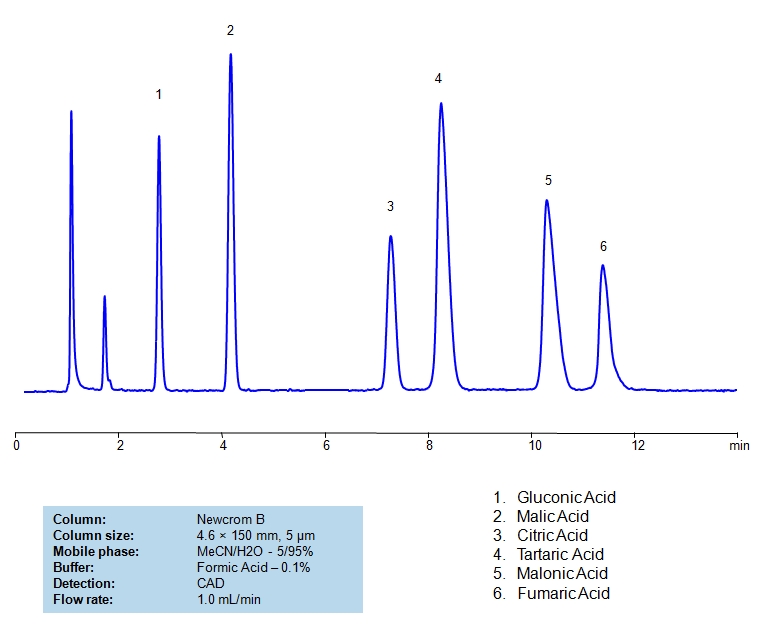
High Performance Liquid Chromatography (HPLC) Method for Analysis of Glycolic acid, Malic Acid, Maleic Acid, Methylmalonic Acid, Succinic Acid, Tartaric Acid, dl-Tartaric acid, Fumaric Acid, Citric Acid, Malonic Acid, Gluconic acid.
Gluconic Acid is an organic acid with the chemical formula C6H12O7. It is naturally found in fruits. Industrially, it is found in honey that is produced by fermenting starch. Typically, it is used in food, beverage, cosmetic, and skin care industries.
Malic Acid is an alpha hydroxy acid with the chemical formula C4H6O5. It is most commonly found in fruits and wines. It is sour, which is partially why it is often used as a food additive. Besides food, it is also used in skin-care as an exfoliant.
Citric Acid is a naturally occurring organic acid found in citrus fruits; it is also an intermediate in the citric acid cycle of aerobic organisms. It is used industrially as an acidity regulator, flavoring, detergent, and more than 2 million tons are produced annually. It’s chemical formula is C₆H₈O₇.
Tartaric Acid is an organic acid with the chemical formula C4H6O6. It is found in fruits like grapes and tamarinds and is a vital component of wine. It is also used in metal cleaning, as an antioxidant, and as an acidulant.
Malonic Acid is an organic compound with the chemical formula C3H4O4. It is also known as cis-butenedioic acid. It is a trans counterpart of fumaric acid. It has a variety of uses from dyeing natural fibers to oil and fat preservative, to synthesis of hydrogels.
Fumaric Acid, also known as trans-butenedioic acid, is an organic compound with C4H4O4 chemical formula. It is used across Food, industrial, and medical industries. In food, is it often used as a preservative, pH regulator, and flavoring akin to citric acid. Industrially, it is used in making polyester resins, polyhydric alcohols, and more. Medically, it is used in denture cleaners and it’s derivatives are used in treating psoriasis.
Glycolic acid, Malic Acid, Maleic Acid, Methylmalonic Acid, Succinic Acid, Tartaric Acid, dl-Tartaric acid, Fumaric Acid, Citric Acid, Malonic Acid, Gluconic acid can be retained and analyzed using the Newcrom B stationary phase column. The analysis utilizes an isocratic method with a simple mobile phase consisting of water and acetonitrile (MeCN). Detection is performed using CAD.
| Column | Newcrom B, 4.6 x 150 mm, 5 µm, 100 A, dual ended |
| Mobile Phase | MeCN/H2O – 5/95% |
| Buffer | AmAc pH 5.0, Formic Acid |
| Flow Rate | 1.0 ml/min |
| Detection | CAD (Corona) MS- compatible mobile phase |
| Class of Compounds | Acid, Hydrophilic, Ionizable |
| Analyzing Compounds | Glycolic acid, Malic Acid, Maleic Acid, Methylmalonic Acid, Succinic Acid, Tartaric Acid, dl-Tartaric acid, Fumaric Acid, Citric Acid, Malonic Acid, Gluconic acid |
Application Column
Newcrom B
Column Diameter: 4.6 mm
Column Length: 150 mm
Particle Size: 5 µm
Pore Size: 100 A
Column options: dual ended
Fumaric Acid
Gluconic acid
Glycolic acid
Maleic Acid
Malic Acid
Malonic Acid
Methylmalonic Acid
Succinic Acid
Tartaric Acid
dl-Tartaric acid

